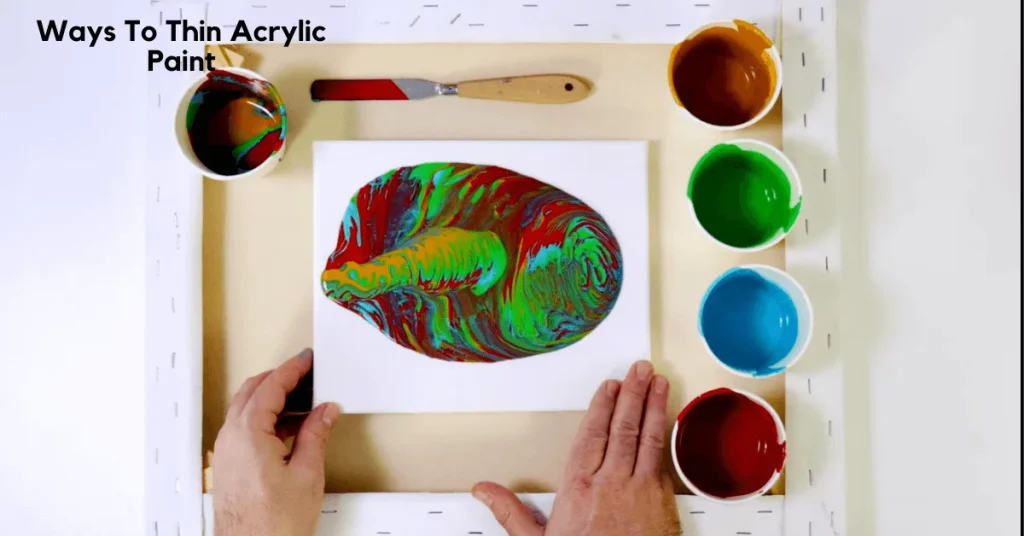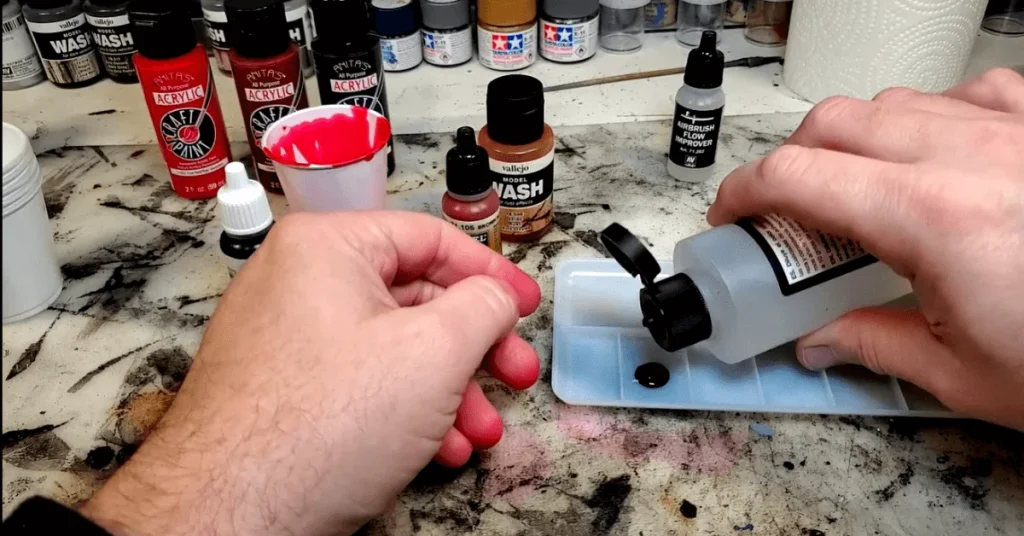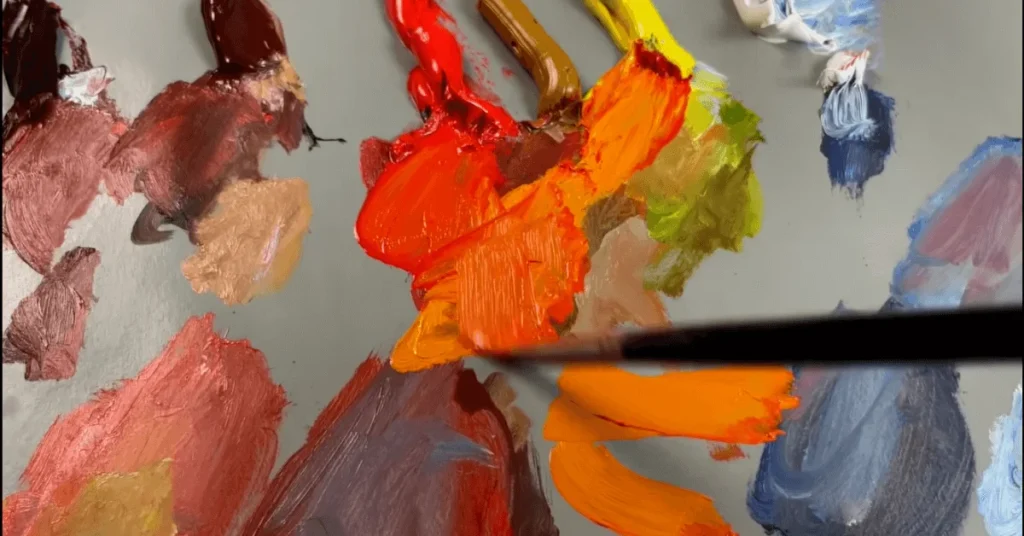What do we mean by thinning acrylic paints? It is the dilution of the paint to achieve a runny, fluid, and less viscous consistency. But how to thin acrylic paint correctly requires the right strategies and thorough guidance, which is why I’m writing this blog for you.
Generally, acrylic paint can be thinned down by adding 30% water to the paint. Moreover, you can also add an acrylic binder, pouring medium, flow improver, and sometimes glazing medium for promising results.
No matter what kind of medium you add to thin the paint for your next project, it is necessary to know the right ratio of the medium to paint. Additionally, there are many other cautions you need to consider.
So, read the post for further instructions, tips, methods, applications, and procedures for acrylic thinning down.
Ways To Thin Acrylic Paint (4 Effective Methods)
Acrylic paint can be thinned using several methods, but I usually use the following ones and believe me, I never get disappointed. So let me share these techniques with you.

- Water
Can you thin acrylic paint with water? Yes, thinning acrylic paint with water is the most common and simplest method. Simply add a small amount of water to the paint and stir it until the desired consistency is achieved.
Remember that adding too much water can dilute the paint’s pigments, making it less vibrant. However, learning different aspects of acrylic paint water solubility is also necessary.
- Acrylic Medium
A thinning medium for acrylic paint is a clear, liquid compound that is specifically designed to be mixed with the paint to change its consistency, gloss level, and drying time.
When used to thin acrylic paint, it can also help to maintain the paint’s original color and consistency.
- Flow improver
This is a type of acrylic medium that is specifically designed to improve the flow of paint and reduce brush marks. It can be added to acrylic paint in small amounts to thin it and make it easier to apply.
- Airbrush Thinner
This is a special type of thinner that is prepared for use with airbrushes. It can be added to acrylic paint to make it thinner and more suitable for spraying.
How To Thin Out Acrylic Paint? Step By Step
Choose any method discussed above and follow these steps to thin acrylic paint for a perfect and desired outcome.

Step 1: Choose A Thinner
To thin acrylic paint, you can use water, acrylic medium, flow improver, glazing or a commercial thinning medium. You should choose the thinner that is best for your painting project, depending on the consistency and finish you want to attain.
Step 2: Prepare Your Workspace
Before you begin thinning your paint, make sure that you have a clean and flat surface to work on. You will also need a palette, a brush, and a container to hold the thinned paint.
Step 3: Pour The Paint Into A Container
Take the amount of paint that you need for your painting project and pour it into a container. Make sure that the container is clean and free of any debris.
Step 4: Add And Mix The Thinner
Slowly add the thinner to the paint, starting with a small amount and gradually increasing the amount until you reach the desired consistency.
Mix the paint and the thinner thoroughly with a brush or palette knife until the paint is smooth and lumped-free.
Step 5: Check The Consistency
To test the consistency of the thinned paint, you can use a brush to paint a line or a stroke on a piece of paper. If the paint is too thick, add thinner to the mixture. If the paint is too thin, add more paint to the mixture.
Step 6: Repeat If Necessary
If you need to thin the paint further, repeat the process of adding thinner and mixing until you require thinness.
You can finally pour the thinned paint into a clean container and store it in a cool, dry place until you are ready to use it. Make sure that the lid is tightly sealed to prevent the paint from drying out.
Tips And Precautions To Follow When You Thin Acrylic Paint
Follow the precautions and tips below to ensure that you are using the right thinner and that you are thinning your acrylic paint in a safe and effective manner.

- Only use water or an acrylic medium designed for thinning acrylic paint. Avoid using solvents like turpentine or mineral spirits, as these can damage the paint and alter its properties.
- Start with a small amount of thinner and gradually add more as needed. It’s easier to add more thinner than it is to try to thicken the paint once it has become too thin.
- Stir the paint thoroughly to ensure that the thinner is evenly distributed and that the paint retains its original color and consistency.
- Thinned acrylic paint has a shorter shelf life than undiluted paint, so be sure to use it within a reasonable amount of time.
- When working with thinners, it is important to wear gloves and a mask to protect your skin and lungs from any fumes.
- Store the thinned paint in a tightly sealed container to prevent it from drying out or becoming contaminated.
Acrylic Paint Thinner Substitutes

There are several alternatives to paint thinner you can use for acrylic paint. However, I’m explaining some of them that I have used and found working.
- White Vinegar
Can you use vinegar to thin acrylic paint? Yes, vinegar can be used as a thinner for acrylic paint, but it is not a traditional paint thinner and may not produce the desired results for your painting project.
Vinegar is an acetic acid and can cause the paint to curdle or react differently than it would with water. Additionally, be aware that vinegar can also change the color of the paint, making it appear slightly yellow or cloudy.
It’s important to keep in mind that using vinegar as a thinner for acrylic paint is not a common practice and is not recommended by most professional artists or paint manufacturers.
- Isopropyl Alcohol
Can you use alcohol to thin acrylic paint? Yes, you can. Isopropyl and denatured alcohols are commonly used to thin acrylic paints. These types of alcohol evaporate quickly, which helps the paint to dry faster.
However, it’s important to note that not all kinds are suitable when it comes to thinning acrylic paint with alcohol, and some may even cause the paint to deteriorate or change color.
Also, remember that too much alcohol can weaken the paint’s ability to adhere to the surface and may cause the paint to dry too quickly, which can result in an uneven application.
- Acetone
Can you use acetone to thin acrylic paint? Yes, acetone can be used to thin acrylic paint. Acetone is a strong solvent that can dissolve and break down the binder in acrylic paint, making it thinner and easier to spread.
However, it is essential to be careful when thinning acrylic paint with acetone, as too much amount can cause the paint to become too thin and lose its color intensity.
Additionally, excessive use of acetone can cause the paint to dry too quickly, which can lead to cracking or an uneven surface.
The Purpose of Thininig Acrylic Paint
- For Canvas
The objective of thinning acrylic paint for canvas is to achieve the desired consistency for a specific technique or style of painting.
The process of how to thin acrylic paint for canvas involves adjusting the viscosity of the paint by adding water, medium, or thinner, allowing it to flow and spread evenly on the surface.
Thinning the paint creates a transparent, translucent, or watercolor-like effect and can enhance the color vibrancy.
By controlling the consistency of the paint, you can create intricate details, delicate washes, and subtle gradations on canvas.
- Acrylic Pouring
Thinning acrylic paint for the pouring technique is a particular strategy for painting and producing exciting, stunning, and remarkable artwork.
The ideal consistency for acrylic pouring is that of heavy cream or thin syrup, as it should be pourable but not so thin that it doesn’t hold its form.
- For Walls
It is necessary to know how to thin acrylic paint for walls. Thinning the paint for application on walls helps to reduce costs and provide a durable color.
However, it’s important to note that too much water can weaken the paint’s ability to adhere to the wall and can also impact the final color and finish. A good rule of thumb is to add no more than 1/2 cup of water per gallon of paint.
- For Wood
You can also thin down acrylic paint to use it over wood. Thinned acrylic paint can penetrate deeper into the wood fibers, which is especially important for porous wood surfaces. This ensures that the paint will adhere better and last longer.
- For Airbrushing
Airbrushing is a technique used to create a smooth, even layer of paint on a surface. For this, you will need an airbrush tool, a compressor, and thinned acrylic paint.
You can learn how to thin and mix acrylic paint for airbrush use by following the methods and procedures discussed above in the post.
However, it’s important to note that some acrylic paints are formulated to be used straight from the bottle and may not require thinning. Be sure to read the manufacturer’s instructions before thinning your paint.
FAQs
How do you thin acrylic paint?
To thin out thick acrylic paint, you may want to add paint thinner or acrylic mediums. However, if you’re looking for an affordable way, you can use water.
What is the best solvent for acrylic paint?
The best solvent for acrylic paint is water. It dissolves in the paint thoroughly. But make sure you don’t add too much water that ruins the paint’s sticking ability.
What do you use to thin acrylic paint?
You can mix a variety of substances, including mediums, acetone, alcohol, water, glazing liquid, and varnish, to make acrylic thin and fluid. But it’s crucial to mix these materials in an appropriate ratio.
Final Verdict
You’ll need to thin paint for many purposes during your career, no matter you’re a professional artist or just a beginner. But knowing how to thin acrylic paint for your project requirements is necessary.
I hope you got your answer and solution to your problems. For queries, kindly comment below.
Thank You!
- How To Buff Acrylic Enamel Paint In 5 Easy Steps? - February 2, 2024
- How To Make Acrylic Paint More Opaque? 10 Effective Methods - February 1, 2024
- How To Sketch On Canvas Before Acrylic Painting? Draw Like a Pro - January 31, 2024

